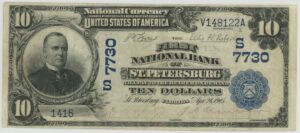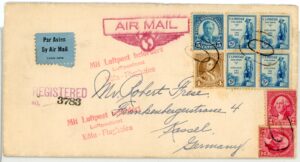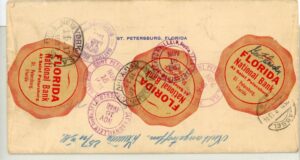SAINT PETERSBURG
The city was co-founded by John C. Williams, formerly of Detroit, who purchased the land in 1876, and by Peter Demens, who was instrumental in bringing the terminus of a railroad there in 1888. St. Petersburg was incorporated on February 29, 1892, when it had a population of only some 300 people.
It was named after Saint Petersburg, Russia, where Peter Demens had spent half of his youth. A local legend says that John C. Williams and Peter Demens flipped a coin to see who would have the honor of naming the city. Peter Demens won and named the city after his home, while John C. Williams named the first hotel after his birthplace, Detroit (a hotel built by Demens). The Detroit Hotel still exists downtown, but has been turned into a condominium. The oldest running hotels are the historic Pier Hotel, built in 1921, formally Hotel Cordova and The Heritage Hotel, built in 1926.
Philadelphia publisher F. A. Davis turned on St. Petersburg’s first electrical service in 1897 and its first trolley service in 1904. The city’s first major industry was born in 1899 when Henry W. Hibbs (1862–1942), a native of Newport, North Carolina, established his wholesale fish business at the end of the railroad pier, which extended out to the shipping channel. Within a year, Hibbs Fish Company was shipping more than 1,000 pounds (450 kg) of fish each day.
Dredging of a deeper shipping channel from 1906 to 1908 opened St. Petersburg to larger shipping. Further dredging improved the port facilities through the 1910s. By then the city’s population had quadrupled to 4,127.
In 1914, airplane service across Tampa Bay from St. Petersburg to Tampa and back was initiated, generally considered the first scheduled commercial airline flight. The company name was the St. Petersburg-Tampa Airboat Line, and the pilot was Tony Jannus, flying a Benoist XIV flying boat. The Tony Jannus Award is presented annually for outstanding achievement in the airline industry. Jannus Live, a local music/entertainment venue on Central Avenue in downtown, is also named after him.
The city population continued to multiply during the 20th century, booming in the 1940s and 1950s and through the 1970s as the town became a popular retirement destination for Americans from midwestern cities, reaching 238,647 in the 1980 census. By that time, however, the population had levelled off, and has grown by only 10,000 since then. In the decade from 2000 to 2010, the population of the city dropped by approximately 4000 residents, while in the same period the population of Florida increased by over two and a half million residents.
Source: Wikipedia
Recent Articles
- Browse Videos of Florida’s Historical Towns and Banks
- Florida Currency Museum Open Showcasing The William Youngerman Collection
- State of Florida Civil War Currency
- Recent Acquisitions
- Mr. and Mrs. Youngerman attend the inagural “The Value of Money” exhibit
Notes & Currency
- 18__ Fernandina $3 Obsolete Note
- 1882 $50 Jacksonville Note Charter #3869
- 1902 $10 Punta Gorda Note Charter #10512
- 1882 $5 Palatka Note Charter #3223
- 1902 $5 Key West Note Charter #7942






















